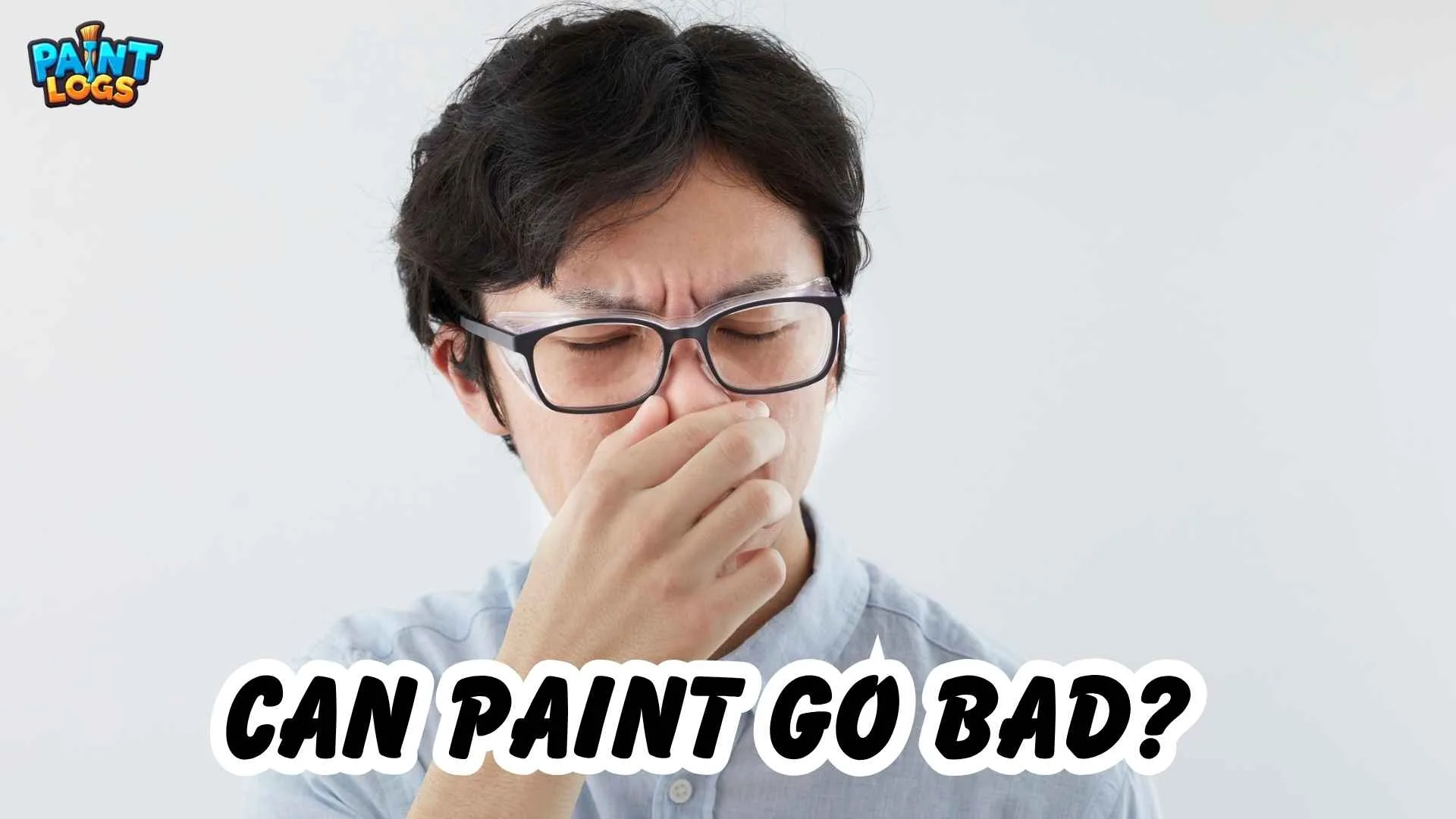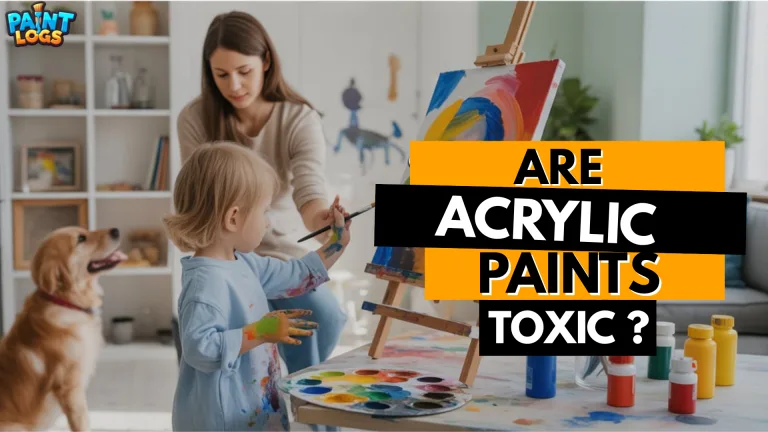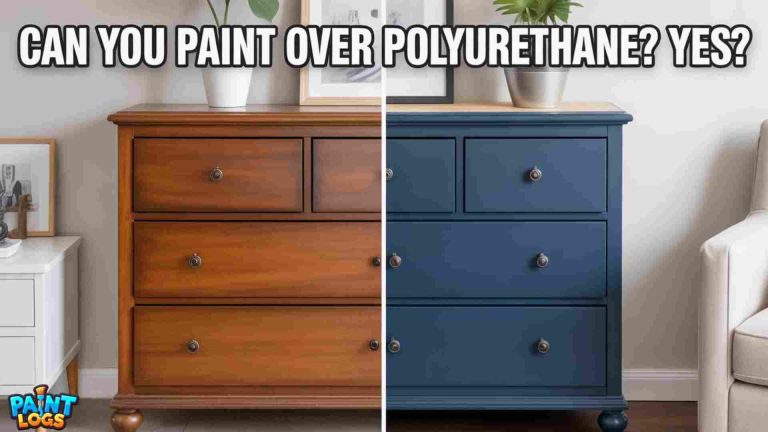Keeping leftover paint is smart, it saves money, helps with touch-ups, and makes future projects easier.
But here’s the truth: paint can go bad if it’s not stored properly or left unused for too long. Spoiled paint often smells terrible, looks clumpy, can be harmful to your health, and may ruin your walls with poor coverage or sticky, uneven finishes.
In this expert guide, we’ll cover:
- Can paint go bad?
- How to tell if your paint has gone bad
- What causes paint to spoil
- How to extend paint shelf life
- When to throw old paint away
- How to dispose of it safely and responsibly
Why Does Paint Go Bad?
Paint is made from pigments, binders, and solvents (either water or oil). Over time, these ingredients separate, dry out, or degrade — especially when exposed to air, bacteria, or temperature swings.
The main culprits:
- Air exposure → oxygen and moisture encourage bacterial growth.
- Extreme temperatures → freezing breaks latex paint emulsions; heat thickens oil paint.
- Dirty tools → dipping a used brush introduces bacteria or mold spores.
- Old age → binders and pigments slowly lose stability even in sealed cans.
Typical Paint Shelf Life
Here’s how long paint usually lasts under proper storage:
| Paint Type | Unopened Shelf Life | After Opening | Notes |
|---|---|---|---|
| Latex / Acrylic | 8–10 years | 2–5 years | Water-based; sensitive to freezing |
| Oil / Alkyd | 15 years | 5–10 years | More stable but flammable |
| Chalk Paint | 3–5 years | 1–2 years | Can dry out faster; stir before use |
| Spray Paint | 2–5 years | — | Keep upright; avoid nozzle rust |
| Primer (latex) | 7–10 years | 2–4 years | Similar to regular latex paint |
Unopened cans stored indoors at steady room temperature often last far longer than expected — but opened paint has a much shorter life once exposed to air.
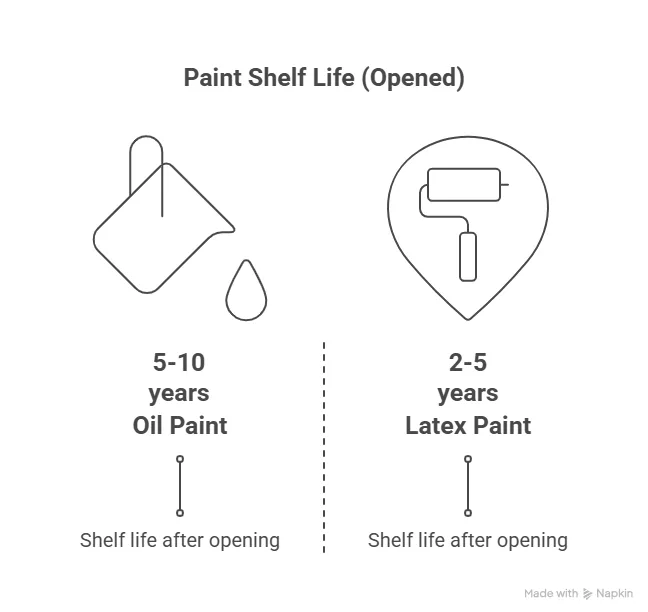
How to Tell If Paint Has Gone Bad
Before you paint, test the can. Here’s what to look for:
1. Strong Sour or Rancid Smell
Open the lid and take a light sniff.
Fresh paint smells like mild chemicals or ammonia. Bad paint smells sour, moldy, or rotten — like spoiled milk or old eggs.
This odor comes from bacteria feeding on organic components in the paint.
If it stinks, toss it. No amount of ventilation will cover that smell once applied.
2. Mold or Mildew Growth
If you see dark spots, fuzzy patches, or film floating on the surface, that’s mold.
Mold grows when paint is contaminated or stored in a damp area. It can also release unpleasant or unsafe fumes when opened — learn more about paint fume safety and ventilation.
Never attempt to “scoop it out.” The entire can is unsafe — dispose of it properly.
3. Thick “Skin” on Top
Over time, air forms a rubbery film on top of opened paint.
- A thin skin can be peeled off — you might still find usable paint underneath.
- A thick or hardened layer means the paint has dried out too much to be revived.
If half the can is solid, it’s beyond saving.
Pro Tip: After removing a thin skin, strain paint through a mesh filter or cheesecloth to remove bits before use.
4. Lumpy or Chunky Texture
Stir the paint thoroughly.
Good paint should feel creamy and smooth.
If it’s full of lumps that don’t dissolve, it’s likely frozen or spoiled.
A gritty, curdled texture means the binders have failed — discard it.
Small specks of dried paint from the lid are harmless and can be strained out, but persistent clumps are a no-go.
5. Separation That Won’t Remix
It’s normal for paint to separate — pigments settle on the bottom, and liquid rises to the top.
But if stirring doesn’t blend it back into a uniform color, it’s gone bad.
Latex paint that’s frozen will often stay watery and uneven even after mixing.
6. Bulging or Leaking Can
A swollen lid or sides indicate gas buildup from bacteria.
Leaking cans or rusty lids mean the seal was broken — and likely the paint, too.
Treat it like spoiled food: bulging can = unsafe contents.
7. Uneven or Sticky Application
Even if the paint looks fine, always test a small area.
Brush some on cardboard:
- It should spread smoothly.
- It should dry within a few hours without stickiness or oily residue.
If it stays tacky or uneven, the chemical balance is off — don’t use it on walls.
Quick Paint Quality Checklist
✅ Normal paint smell
✅ Smooth texture after stirring
✅ No mold or gas buildup
✅ Applies evenly and dries fully
If your paint passes all four — it’s likely still good to use.

How to Extend the Shelf Life of Paint
Proper storage can easily double the lifespan of your paint.
1. Seal the Can Tightly
After painting:
- Wipe paint from the rim so the lid seals flat.
- Tap gently around the lid with a rubber mallet.
- Add plastic wrap or wax paper under the lid for an airtight barrier.
- If the lid is bent or rusted, transfer paint into a smaller airtight container.
Optional: Some painters store sealed cans upside down (lid down) to prevent air entry — but only if you’re sure it’s tightly closed.
2. Store in a Climate-Controlled Space
Avoid garages, sheds, or attics. Temperature swings cause condensation and spoilage.
Best storage:
- Indoors (closet, utility room, or basement shelf)
- Cool, dry conditions (60–80°F / 15–27°C)
- Humidity under 65%
Place cans on wood or cardboard, not directly on concrete floors (to prevent rust).
3. Reduce Air in Partially Used Cans
The less air, the longer paint lasts.
- Pour leftovers into smaller containers.
- Drop in clean marbles or rocks to raise the liquid level.
- Use only clean tools — never dip a dirty brush into the main can.
4. Keep It Upright and Labeled
Label each can with:
- Paint color name and code
- Where it was used
- Date opened
Also, dab a small paint sample on the lid — this makes future touch-ups easier.
5. Stir Before Storing (Optional)
Give the paint a quick stir before sealing to re-suspend pigments.
Some pros also reopen and stir old cans once a year to keep the mixture consistent.
6. Avoid Contamination
Always pour paint into a separate tray rather than painting directly from the can.
This prevents dirt, bacteria, or dried flakes from falling in.

When to Throw Paint Away
Knowing when to let go saves you time and frustration.
Throw It Away If:
- It smells bad or shows mold.
- It’s heavily clumped or won’t mix smooth.
- The can is rusted, bulging, or leaking.
- It’s more than 10 years old and untested.
- The color has changed dramatically or no longer matches your wall.
- You have too many partial cans you’ll never reuse.
Rule of thumb:
If the paint is questionable, it’s not worth risking a ruined wall.
The price of a new gallon is cheaper than the cost of repainting a failure.
Manufacturer Lifespan Guidelines
- Sherwin-Williams: ~3 years after manufacture for most latex paints.
- PPG: ~2 years opened.
- Oil-based paints: 5–15 years if sealed and stored properly.
These are conservative; well-stored paints can last much longer, but age always increases risk.

Safe Disposal of Old Paint
Never pour paint down the drain or into the soil — it can harm pipes and waterways.
Follow these safe, eco-friendly methods:
1. Use It Up or Donate It
If the paint is still usable, try to:
- Recoat baseboards, fences, or closets.
- Donate to a community group, school, or Habitat for Humanity ReStore.
- Offer on neighborhood apps for free reuse.
This keeps paint out of landfills and helps others save money.
2. Dry Out Latex (Water-Based) Paint
Latex paint becomes safe for trash once it’s fully dry.
How to dry it quickly:
- Remove the lid and leave small amounts open to air.
- For larger volumes, mix in:
- Cat litter
- Sawdust
- Shredded paper
- Commercial paint hardener
- Pour thin layers into a cardboard box lined with plastic.
- Once solid, dispose of it with your regular trash (lid off).
Never pour liquid paint into drains — it can clog pipes and contaminate water.
3. Dispose of Oil-Based Paint Properly
Oil or alkyd paints contain flammable solvents and are considered hazardous waste.
- Take them to your local Household Hazardous Waste (HHW) center.
- Many U.S. states partner with PaintCare, which has free drop-off sites at paint stores.
- Never throw oil paint in household trash or burn it.
4. Empty or Dried Cans
If the can is empty or the paint inside is completely hardened:
- Leave the lid off to show it’s dry.
- Recycle it as scrap metal (if accepted locally).
- Otherwise, discard it in household trash.
5. Other Paint Products
- Thinners, varnishes, stains → treat as hazardous waste.
- Spray paint cans → recycle only when fully empty (no hissing sound).
- Wet cans → take to HHW facility.
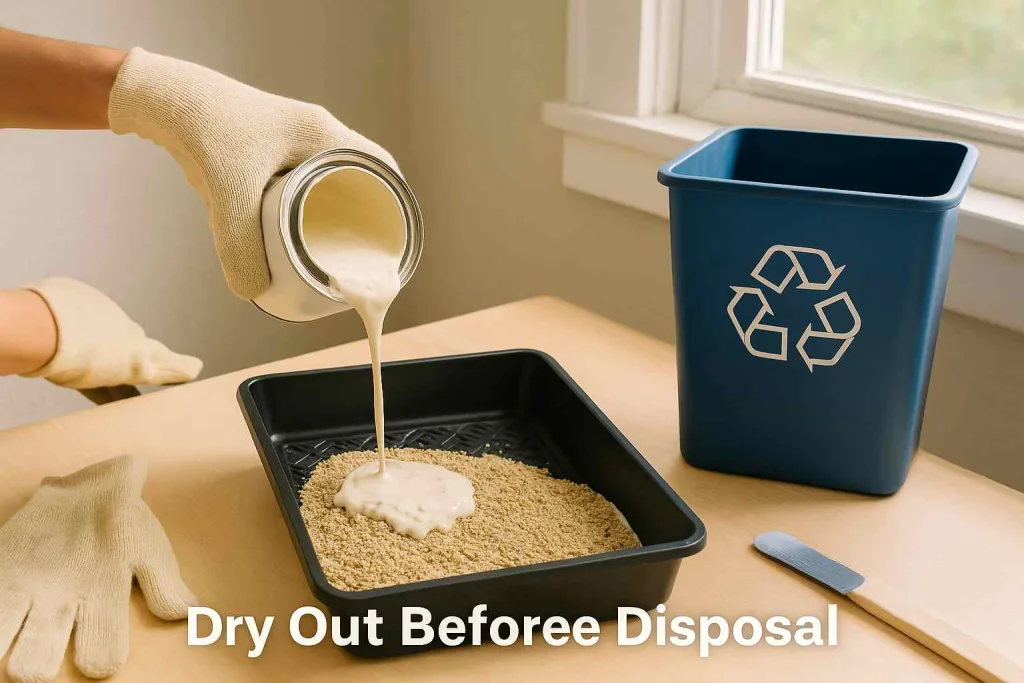
Environmental Reminder
The U.S. Environmental Protection Agency (EPA) estimates that over 10% of all paint sold each year is never used.
Proper disposal helps reduce pollution and keeps harmful chemicals out of waterways.
Always check local disposal rules, every region has slightly different recycling programs.
Conclusion: Does Paint Go Bad?
Paint is durable, but not immortal.
With good storage, latex paint lasts 5–10 years, and oil paint can last 15 years or more.
Check smell, texture, and color before every use, and store cans sealed tightly in stable indoor temperatures.
When paint smells foul, won’t mix, or looks chunky — don’t risk it. Dispose of it safely or donate usable leftovers.
A few minutes of inspection and sealing can save you hours of repainting and ensure every coat looks clean, smooth, and fresh.
FAQs
Can paint go bad even if unopened?
Yes — though unopened cans last much longer. Over many years, pigments can still separate and the binder dry out slightly. Always stir and test before using.
What happens if I use expired paint?
Old or spoiled paint can lead to:
Patchy or uneven coverage
Sticky or slow-drying walls
Foul lingering odors
Paint that peels or bubbles within months
If you see these results, remove the paint and start fresh.
How can I test old paint before using it?
Open and sniff for sour odor.
Stir for 2–3 minutes.
Brush on cardboard.
Let dry overnight.
If it dries evenly and smells normal, it’s likely still usable.
Is it okay to thin old paint with water or thinner?
Only if it’s thick but still smells and looks normal.
Add up to 10% clean water (for latex) or mineral spirits (for oil) and stir thoroughly.
If it remains clumpy or separates again, discard it.
Can paint freeze and still be good?
If latex paint freezes once and thaws slowly, sometimes it’s okay.
But repeated freeze-thaw cycles ruin the emulsion — it will stay watery or gritty.
Oil paint tolerates cold better but should still be tested first.
Where should I store paint long-term?
Temperature: 60–80°F (15–27°C)
Humidity: below 65%
Location: dark, dry, climate-controlled (closet or basement shelf)
Away from: sunlight, heaters, or damp concrete floors

